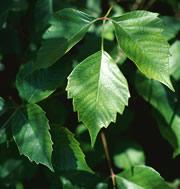 Ouch: the itch from poison ivy can be soothed by skin creams — maybe ones made from cannabis.Getty
Ouch: the itch from poison ivy can be soothed by skin creams — maybe ones made from cannabis.GettyThe chemicals that give marijuana its mood-altering kick might also be an option for treating skin allergies, according to a study done in mice.
The compounds, called cannabinoids, have been credited with everything from stimulating the growth of new neurons to easing the symptoms of multiple sclerosis. Although they are best known for spicing up marijuana, the body also produces cannabinoids, which are thought to play a part in learning and in communications between the immune system and the nervous system. Now, researchers have shown that cannabinoids can relieve some of the swollen, itchy agony of allergic skin reactions in mice.
The team first noticed the effect when they created mice that lacked two proteins that usually recognize cannabinoids produced by the body. Some of the mutant mice scratched at the metal identification tags in their ears until the area around the tags became raw and covered with sores. "We thought at first it was just an itching phenotype," says Andreas Zimmer, a neurobiologist at the University of Bonn. "But then we switched to another brand of ear tags and all of a sudden the problem completely disappeared."
The first set of tags, it turned out, contained nickel, whereas the second set was made from non-allergenic brass. Zimmer and his colleagues realized that the mutant mice were allergic to the nickel. Mice that still had their cannabinoid receptors did not react in this way.
The results suggested that cannabinoids produced by the body might help protect the animals against skin allergies. To find out whether the compounds could produce the same effect when applied externally, Zimmer's research team applied a cannabinoid to the skin of mice before and after they were exposed to a chemical (called 2,4-dinitrofluorobenzene), which is known to produce an allergic response. Mice that had received the cannabinoid had a diminished allergic response, with about 50% less swelling, than did those that had not received the compound. The results are published this week in Science.1
Swell treatment
No one knows precisely how cannabinoids diminish allergic reactions, but Zimmer and his colleagues did find that the compounds alter the expression of genes that encode small proteins called chemokines. And some chemokines are known to promote inflammation.
Zimmer's mice received their cannabinoid treatment both before and after their encounter with the allergen, so it wouldn't necessarily work after a chance encounter with, for example, poison ivy. The best defence against most contact allergies is simply to avoid contact with the allergens, says Thomas Tüting, a dermatologist at the University of Bonn and a co-author of the study.
ADVERTISEMENT
But the treatment could be useful for treating patients with chronic dermatitis, says Thomas Klein, an immunologist at the University of South Florida in Tampa. People with this condition have recurrent patches of swollen, itchy, cracked skin, and they don't always know the cause. "It's very uncomfortable and the wounds carry the risk of secondary infections," says Klein. The usual treatment is steroids and immunosuppressants. But long-term use of steroids can cause the skin to thin and patients often become tolerant of the drugs, rendering the medication less effective. An alternative treatment would be a welcome addition, says Klein.
But no therapeutic application is certain until the experiments have been repeated in humans, cautions Roman Rukwied, who studies pain and inflammation at the University of Heidelberg in Germany. "We are far before the day when we could say 'oh, I have a nickel allergy. I will smoke marijuana and I won't have it anymore'," he says. "That is definitely not the case."
Visit our skincreamcouldhel.html">newsblog to read and post comments about this story.
